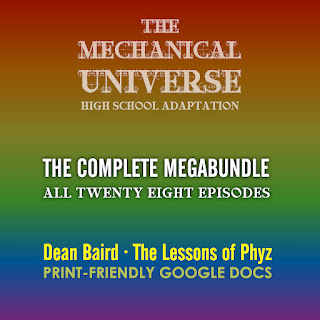The Mechanical Universe...and Beyond is a critically-acclaimed series of 52 thirty-minute videotape programs covering the basic topics of an introductory university physics course. The series was originally produced as a broadcast telecourse by the California Institute of Technology and Intelecom, Inc. with program funding from the Annenberg/CPB Project.
Each program in the series opens and closes with Caltech Professor David Goodstein providing philosophical, historical and often humorous insight into the subject at hand while lecturing to his freshman physics class. The Mechanical Universe contains hundreds of computer animation segments, created by Dr. James F. Blinn, as the primary tool of instruction. Dynamic location footage and historical re-creations are also used to stress the fact that science is a human endeavor.
Upon completion of the broadcast telecourse, Professor Richard Olenick, Associate Project Director, received funding from the National Science Foundation to produce a seven-hour High School Adaptation suitable for high school physics students.
The series has been broadcast as a telecourse over the PBS television network and can still be seen on many PBS stations. The Mechanical Universe is arguably the most successful attempt to date to use video technology in the presentation of rigorous physics instruction.
This was my first product offered for sale on Teachers Pay Teachers: question sets for a video series produced more than 30 years ago. Videos that were no longer offered for sale and had never been uploaded for streaming. If you were not already in possession of these High School Adaptations of The Mechanical Universe, you could not get them "for love or money." Such is the mark of my business acumen.
Nevertheless they sold. I eventually uploaded the videos to my own YouTube account and awaited copyright claims. Crickets. It was as I had suspected: no one was selling physical copies, and no one was selling streaming access. So these versions join their college edition siblings as freely available resources streaming on YouTube.
I wrote these questions because I wasn't happy with the question sets provided by the publisher when my school purchased the High School Adaptation set in the early 1990s. Those required long-form answers that took students out of the moment while the episode played. I wanted to keep them engaged with the episode without needing to pause the video.
SETS AND EPISODES
1.1. THE LAW OF FALLNG BODIES
Do heavier bodies fall faster than lighter ones? The way that Galileo arrived at an answer to this question was as revolutionary as the answer itself. Although Galileo could not create a vacuum, he could imagine one, and so he realized that in a vacuum all bodies fall with the same constant acceleration. In this video, Galileo’s investigation of the law of failing bodies is presented with an emphasis on scientific methods. Galileo’s pioneering work in quantifying empirical data earned him the title of “The Father of Modern Science.”
